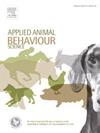Living on the edge: Detections and activity pattern of wildcats (Felis silvestris) and domestic cats (Felis catus) by camera trapping in areas of low wildcat population density
IF 2.2
2区 农林科学
Q1 AGRICULTURE, DAIRY & ANIMAL SCIENCE
引用次数: 0
Abstract
The European wildcat (Felis silvestris) is one of the most endangered European mammal species and it is strictly protected in Hungary. Its population status was previously unknown in the western part of the country, in the region bordering Austria and Slovenia, which may be the peripheral distribution area of wildcats and where it is sympatric with the frequently occurring free-ranging domestic cats (Felis catus). We aimed to detect the presence of wildcats and domestic cats by camera trapping to determine the ratio of the two species and analyse the differences between their diel activity patterns in an area where wildcats were considered rare. We conducted the survey over 31 months, mainly in natural forests and surrounding areas, using camera traps and scent lures at 47 locations. We analysed data from 14,065 cumulative camera-trap days. The two species (and their suspected hybrids) were identified on the basis of their pelage characteristics. Wildcats were photographed at 55.3 % of the locations, and domestic cats at 46.8 %. The presence of both species overlapped at 42.3 % of wildcat locations. We identified 47 individuals with wildcat traits (including at least 20 hybrids) and 45 domestic cats. Wildcat abundance was low and varied significantly across areas. The mean number of unique detections per 100 camera-trap days was 0.77 for wildcats and 1.68 for domestic cats. Both species showed mainly nocturnal activity, with a significant difference in activity patterns observed only in spring. Their behavioural response to attractants differed; after scent-baiting, the detection frequency of wildcats increased slowly before decreasing again, while the domestic cat had a fast increase in the attractant effect at first, which gradually decreased. We could detect the presence of individuals with convincing wildcat phenotype outside their previously known range across large areas far from each other. We collected evidence of frequent invasive domestic cat occurrences inside wildcat habitats. Also, we recorded the activity patterns of the two species in their shared natural habitat with cameras. The knowledge gained from the research can be used to establish a conservation action plan for the wildcat and its habitat.
求助全文
约1分钟内获得全文
求助全文
来源期刊

Applied Animal Behaviour Science
农林科学-行为科学
CiteScore
4.40
自引率
21.70%
发文量
191
审稿时长
18.1 weeks
期刊介绍:
This journal publishes relevant information on the behaviour of domesticated and utilized animals.
Topics covered include:
-Behaviour of farm, zoo and laboratory animals in relation to animal management and welfare
-Behaviour of companion animals in relation to behavioural problems, for example, in relation to the training of dogs for different purposes, in relation to behavioural problems
-Studies of the behaviour of wild animals when these studies are relevant from an applied perspective, for example in relation to wildlife management, pest management or nature conservation
-Methodological studies within relevant fields
The principal subjects are farm, companion and laboratory animals, including, of course, poultry. The journal also deals with the following animal subjects:
-Those involved in any farming system, e.g. deer, rabbits and fur-bearing animals
-Those in ANY form of confinement, e.g. zoos, safari parks and other forms of display
-Feral animals, and any animal species which impinge on farming operations, e.g. as causes of loss or damage
-Species used for hunting, recreation etc. may also be considered as acceptable subjects in some instances
-Laboratory animals, if the material relates to their behavioural requirements
 求助内容:
求助内容: 应助结果提醒方式:
应助结果提醒方式:


